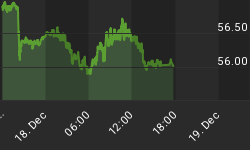Early last week, Wal-Mart announced that its same store sales increased 0.5% in October, which was less than the 1.5% gain analysts were expecting. This proved to foreshadow October results from most retailers. According to First Call, same store sales rose 3.0% in October, which was shy of the 3.5% increase analysts were expecting. In aggregate, the shortfall was due to the poor results at Wal-Mart. Excluding Wal-Mart, October same store sales increased 4.9%, matching analysts' estimates. Department stores were among the best performing retailers last month, up 5.9% gain. Nordstrom's was the standout, posting a same store sales increased of 10.7%. Specialty apparel was the weakest segment with same store sales declining by 1.0%. Gap is the heaviest weighted company in First Call's specialty apparel index and its same store sales dropped 7.0%, which was significantly worse than the 2.4% drop analysts forecasted. Gap had quite a bit of company. In fact, 57% of retailers failed to achieve results that were up to analysts expectations. This was the worst showing since February this year and a significant decline from last month when only 28% of the retailers missed. Wal-Mart added insult to injury by announcing that it expects November sales to be flat with last year. If Wal-Mart is correct and its November same store sales are flat with last year, it would be the weakest result since April 1996.
The initial spin is that consumers are resting before the holiday season. While this could be the case, a larger factor is likely that the robust sales from last year are making the year-over-year comparisons much tougher. According to the ICSC, the year-over-year results in weekly same store sales last November were between 3.9% and 5.1%. Same store sales have not picked up during the first week of November. The ICSC reported that chain store sales increased 2.3% last week, the same as the previous week.
October's employment report topped off a busy week of economic data on Friday. The Labor Department reported that 92,000 jobs were added during October. While this was lower than the 123,000 economists expected, the number of new workers hired in September and August was revised higher. September job gains were revised higher to 148,000 from 51,000 and August was revised higher by 42,000 to 230,000. Initially, it was reported that 128,000 jobs were added in August. The household survey showed another robust month, adding 437,000 jobs. This pushed the unemployment rate to 4.4%. This was the lowest unemployment rate since May 2001. Average weekly earnings increased 0.7% in October and are 4.2% higher than a year ago.
There is no sign of a bottom in the housing market. This week, Toll Brothers, Hovnanian and Beazer Homes reported preliminary fourth quarter results. Toll Brothers experienced a 10% drop in revenue to $1.81 billion. Additionally, net orders continued to plunge, down 56% compared to last year due to cancellations surging to 37% from only 2% last year. Its developments in Orlando and Northern California had the largest increases in cancellations. Toll Brothers expects to take $50 million to $100 million in land or land option write-downs during the fourth quarter. The company also lowered its guidance for the number of deliveries for 2007 to between 6,300 to 7,300 homes. Previously it expected to build between 7,000 and 8,000 homes. The company commented that, "We continue to look for signs that a recovery is imminent but can't yet say that one is in sight." Beazer's CEO, Ian McCarthy, iterated similar comments, "Despite recent references to signs of a bottoming or even the beginning of a recovery, we have not yet seen any meaningful evidence to suggest that a rebound in the housing market is imminent." Hovnanian announced the largest large charge off of the major homebuilders thus far. The builder said it will take a $300 million charge during the fourth quarter. It's likely that the charges homebuilders take during the fourth quarter will be high than the charges taken in the third quarter. Not only has the market softened since the third quarter, year end results will be audited. This will likely cause land values to come under more scrutiny.
Third quarter earnings have continued to exceed analysts estimates. With about 85% of the S&P 500 having reported third quarter results, 73% have exceeded analysts' estimates. Additionally, earnings are projected to increase 18.8% over last year's third quarter. This would be the largest jump in earnings since the fourth quarter of 2004. While earnings growth for the third quarter has been revised higher over the past month, Estimates for the fourth quarter continue to fall. Fourth quarter earnings growth is now expected to be only 9.8%, down from 12.8% on October 1. The four sectors that are expected to be the largest drag on earnings growth are: energy, consumer discretionary, telecom and utilities. Energy companies are expected to see earnings growth collapse. During the third quarter, earnings in the energy sector increased 25% and are expected to drop 7% in the fourth quarter. Earning at utilities companies are also expected to decline in the fourth quarter, down 1%. This is down from the 19% growth last quarter.
Suddenly, the consumer appears tired. This happened when most analysts thought lower energy prices and lower interest rates, not to mention higher wage gains, would overcome other factors weighing on consumers, namely the weak housing market. While same store sales results were generally weak, it should be remembered that total sales increased by 6.7%. Retail analysts focus on same store sales and retailers have been aggressively adding retail space that can mask the strength of overall spending. While total consumer spending might only weaken slightly, individual retailers could come under significant pressure.















